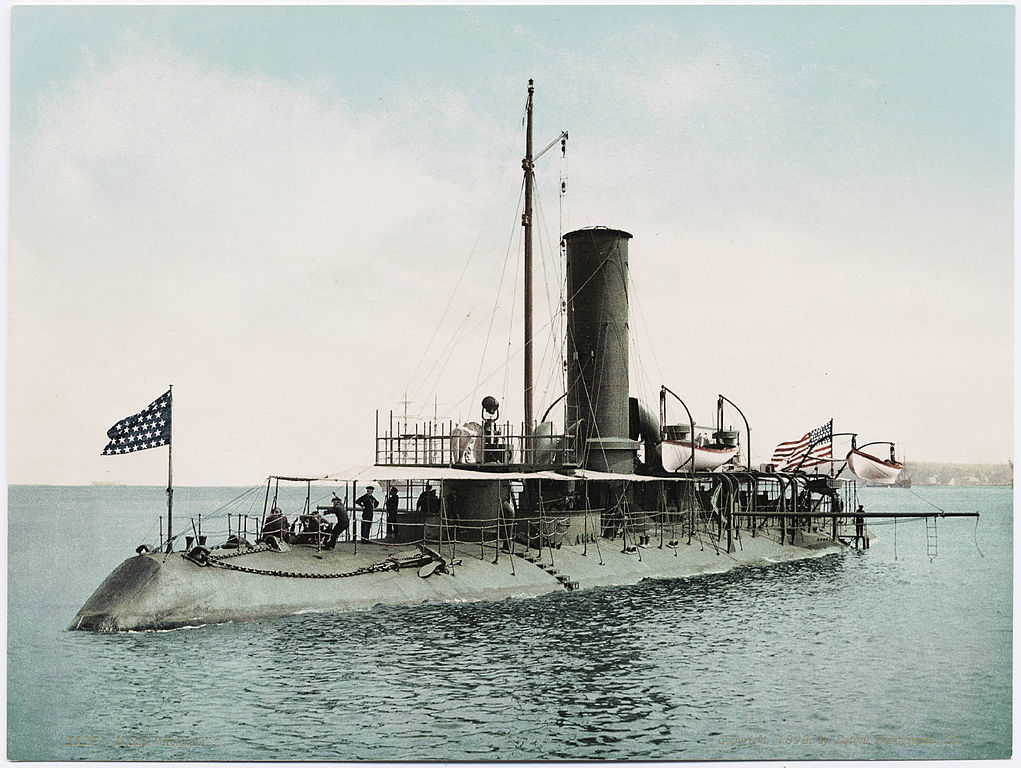
The USS Katahdin, an armoured ram built in the mid-1890s, had a
disastrous history. She was out of date when she was launched and too slow and
unmanoeuvrable for use at sea as a ram ship. Waves broke over the exposed gun
positions and below decks life was cramped and airless due to the poor
ventilation. She saw service in the Spanish-American war on the east coast.
US armoured ram, completed 1895. The American Civil War saw
the revival of the idea of the use of the ram as a primary weapon for sinking
ships. The Confederates began building several armoured vessels using the ram
as their main weapon and one of them, Manassas, actually used her ram in
action. The apparent success of the ram at the battle of Lissa in 1866, and in
sinking a number of ships in accidental collisions, helped to maintain the
popularity of the ram as a weapon in the 1870s and 1880s. Numbers of naval
officers, including the US Admiral Ammen, continued to press for small,
manoeuvrable fast vessels to be built, with sloping armoured sides, and a low
silhouette, with the ram as their chief weapon. The French had already produced
a series of such rams for harbour defence, and these were wholly unsuccessful.
The prime example of this kind of craft, however, was supposed to be the British
Polyphemus, launched in 1881. However this was not really so, as Polyphemus was
intended chiefly as a seagoing torpedo ship, and the ram was merely a secondary
weapon. Finally, after much discussion, the US Navy decided to order its own
armoured ram in 1889. By this time the concept was totally out of date. Not
only had it been fairly well proved that it was very difficult to ram another
vessel which was still capable of steering and steaming and did not want to be
rammed, the navies of the world were also equipped with quick-firing guns which
would make a close approach highly dangerous, if not lethal. What had made some
sense in a period when guns were very slow firing, inaccurate, and
short-ranged, no longer did so.
To make matters worse Katahdin (named after a mountain in
Maine) was not launched at the Bath Iron Works yard until 1893, and was only
completed in 1895. She compared extremely badly with Polyphemus both in design
and performance. She had no torpedoes at all, relying entirely on her ram, and
the four 6-pdrs given her for defence were not mounted on a flying deck, as in
her British predecessor, but on the hull, with a 1.47 m (4 ft 10 in) freeboard,
where they were liable to be washed down by the enormous waves raised when the
ship attempted to make any sort of speed. She never made her design speed of 17
knots, despite the enormous funnel designed to give the best possible natural
draught. Perhaps even worse was her appalling manoeuvrability and difficulty of
steering, which made it unlikely she would ever succeed in her designed role.
Life inside the low-lying hull was most uncomfortable for the crew because of
the heat, lack of ventilation and poor layout. It was not until the
Spanish-American war broke out in 1898 that she was placed in service, guarding
the Atlantic coast of America. Despite a press outcry she was never sent to
engage the Spanish fleet, which was just as well. Very few warships have ever
been quite so obviously useless. It was no surprise when she was discarded and
sunk as a target in 1909.
Displacement: 21 55 tons Length: 76.42 m (250 ft 9 in) wl
Beam: 13.23 m (43 ft 5 in) Draught: 4.57 m (15 ft) Machinery: 2-shaft triple-expansion=
4800 ihp (design), 5068 (trials) = 16 knots Protection: 1 52-76 mm (6-3 in)
Armament: 4 6-pdr Crew: 97